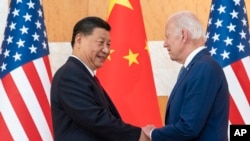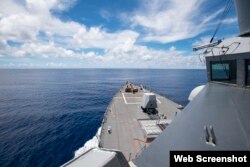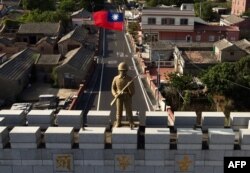U.S. Vice President Kamala Harris is set to visit the Philippines’ province of Palawan on November 22.
Harris will be the highest-ranking American official to visit Palawan, an island chain that is a few hundred kilometers to the east of the Spratly Islands, a disputed archipelago in the South China Sea.
Russia state media has portrayed the announced visit as meant to inflame tensions with China. This, after U.S. President Joe Biden just held calming talks with his Chinese counterpart Xi Jinping at the G-20 summit in Bali, Indonesia.
“The U.S. is preparing for a provocation comparable to [U.S. House Speaker Nancy] Pelosi's visit to Taiwan,” state-run Sputnik reported.
“China may beef up its defenses in the Spratly Islands following the U.S. vice president's visit to Palawan. Progress in resolving the South China Sea issue deprives the United States of the tools to exert pressure on China.”
But it’s false to equate Pelosi’s August visit to Taiwan with Harris’ planned visit to Palawan. The two are apples and oranges.
Beijing claims the island of democratic Taiwan as its territory. Though China also claims control of the Spratly Islands, Palawan is incontestably recognized as a part of the Philippines, by treaty a U.S. ally and important security partner.
What’s more, China’s militarization of the South China Sea [and Spratly Islands] has prompted the Philippines to ramp up military cooperation with the U.S.
Let’s step back a bit.
In 2009, China claimed it has “indisputable sovereignty over the islands in the South China Sea and the adjacent waters, and enjoys sovereign rights and jurisdiction over the relevant waters as well as the seabed and subsoil thereof.”
This includes the Spratly Islands, which also are claimed in part or in whole by six other countries. (The U.S. has not weighed in on those sovereignty claims but maintains freedom of navigation operations in the region).
The Philippines challenged China’s claims at the international Permanent Court of Arbitration, and in 2016, the court largely found in the Philippines’ favor.
The court did not rule on issues of territorial sovereignty or maritime boundaries in the South China Sea, but it did reaffirm the right of states to operate within their exclusive economic zones (EEZs). These zones are recognized in the U.N. Convention on the Law of the Sea as the 200-nautical mile stretch of sea from the coast of a state.
China has ignored the court. China continues to assert claims inside the Philippines’ EEZ and periodically denies the Philippines the right to operate there.
Take Mischief Reef, an atoll in the eastern part of the Spratly Islands located 201 kilometers from Palawan Island and 962 kilometers from China’s Hainan Island.
Mischief Reef falls within the Philippines’ EEZ, yet China took control of it in 1994.
The Sputnik report claimed China may beef up its defenses in the Spratly Islands in response to Harris’ visit. But China has been doing that already, having fully militarized Mischief Reef and other features in the Spratly Islands.
China’s People’s Liberation Army (PLA) has built facilities on six of the 15 Spratly Islands features it occupies, including Subi Reef, which is 26 kilometers from Thitu Island in Palawan province.
Beijing has installed anti-ship cruise missiles and surface-to-air missile systems on three of its fortified Spratly Island outposts.
China also seized the Scarborough Shoal, 220 kilometers east of the Philippines island of Luzon. China’s military blockade of the shoal violates the international court’s 2016 ruling.
In March 2021, the Philippines’ Department of Foreign Affairs intensified demands that China withdraw dozens of “maritime militia” ships “moored, anchored and stationary at Julian Felipe Reef,” in the Spratly Islands and the Philippines’ EEZ, Radio Free Asia (RFA) reported.
(RFA is a sister U.S. government-funded news organization to the Voice of America and Polygraph.info.)
In April 2021, two missile-equipped Chinese navy vessels chased a Philippine civilian vessel with a news crew on board 144 kilometers from mainland Palawan.
In November 2021, China’s coast guard blocked and used water cannons against Philippine resupply ships headed to the Second Thomas (Ayungin) Shoal, a submerged reef in the Spratly Islands that is within the Philippines’ EEZ.
The Philippines has lodged more than 300 diplomatic protests against Beijing's actions in the South China Sea. Former Philippine President Rodrigo Duterte said war could erupt with China if the Philippines asserts its rights in its EEZ.
Thus, Sputnik’s claims that the U.S. is meddling in the South China Sea disputes so it can continue “exerting pressure on China” does not reflect the reality of what’s actually been happening in the South China Sea.
In fact, China has been systematically exerting pressure on its neighbors.
The Philippines and U.S. signed a mutual defense treaty in 1951 and an enhanced defense agreement in 2014 allowing for a bigger U.S. military presence.
On November 15, Manila announced that the United States would spend $66.5 million toward construction of training and warehouse facilities at three of its military bases, Reuters reported.
Rather than provoking China, South China Sea expert Gregory Poling told Reuters that Harris’ visit would signal U.S. support to the Philippines “without angering Beijing,” as the visit is not to a disputed territory.
"It will be reassuring to the Philippines by sending a clear signal that, even with Ukraine and Taiwan center stage, the United States still recognizes the South China Sea as central to the future of the U.S.-Philippine alliance," said Poling.
The situation regarding Taiwan is a different matter.
During talks with Biden in Bali, Xi stressed Beijing’s view that Taiwan is an integral part of China.
"The Taiwan question is at the very core of China's core interests, the bedrock of the political foundation of China-U.S. relations, and the first red line that must not be crossed in China-U.S. relations,” Xi said, according to news reports.
On August 2, Pelosi visited Taiwan to “honor America’s unwavering commitment to supporting Taiwan’s vibrant democracy” and reaffirm U.S. support for their shared interests, “including advancing a free and open Indo-Pacific region.”
China responded by ramping up military drills around Taiwan, bringing tensions to their highest level in decades.
The U.S. is considering an “unprecedented” military aid package for the island nation, with U.S. lawmakers arguing they should do for Taiwan what they should have done for Ukraine — arm the island before China invades.
Taiwan’s democratically elected government rejects Chinese Communist Party rule, and operates as an independent country, although it has never officially declared independence.
In 1971, the United Nations General Assembly recognized the People’s Republic of China as China’s “only legitimate representatives” at the U.N., and expelled representatives of the Republic of China [Taiwan] from the body.
The U.S. maintains a "One China" policy, under which Washington recognizes the Chinese Communist Party as “the sole legal government of China” but leaves the status of Taiwan undetermined while only “acknowledg[ing]” Beijing’s position that Taiwan is part of China.”









